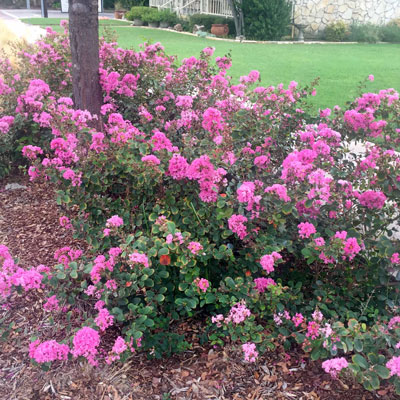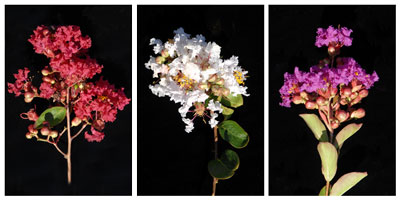Possible Replacement for Roses with RRV
You know I love crape myrtles. But I try not to obsess on them. Rose rosette virus has been running rampant over rose gardens in and around the Metroplex (and elsewhere) for the past five or six years. It’s gotten so bad in DFW that it’s difficult to find attractive rose plants with healthy blooms. Those of us who live here wonder why we were singled out.
If you’re unfamiliar with this disease, here is the information I’ve left on my website for the past two years or more. If you read to the bottom you’ll see that I didn’t initially single out dwarf crape myrtles as being my choice as the best replacements. However, I’m ready to declare them the winners, at least for now.

Photo: This planting of Petite Pink dwarf crape myrtles has been in full bloom several times this summer. I took this photo Monday evening with my iPhone, so it really doesn’t do it justice, but you get the idea.
Why I’m casting my vote for these plants…
Here are the advantages of these dwarf crape myrtles:
• Bloom for longer periods of time from late May or early June into September;
• Stay short (3 to 4 feet tall and wide);
• Often have attractive fall color (deciduous, but roses are for the most part as well);
• Drought-tolerant;
• Relatively pest-free compared to most types of roses.

Photo: This planting of Petite Red crape myrtles makes a good substitute where red Knockout roses might have been previously.
There are many good dwarf crape myrtle selections, but my favorites remain the Petite series. They were introduced more than 50 years ago by Monrovia Nursery Company (wholesale only), but they’re still outstanding. Not every retail nursery will offer them, but they’re still being grown and sold. Your best chance of finding them, as with most crape myrtle varieties, will be in early summer. They include:
• Petite Embers (red)
• Petite Pink (bright pink)
• Petite Plum (deep plum purple)
• Petite Red (dark red)
• Petite Snow (white)

